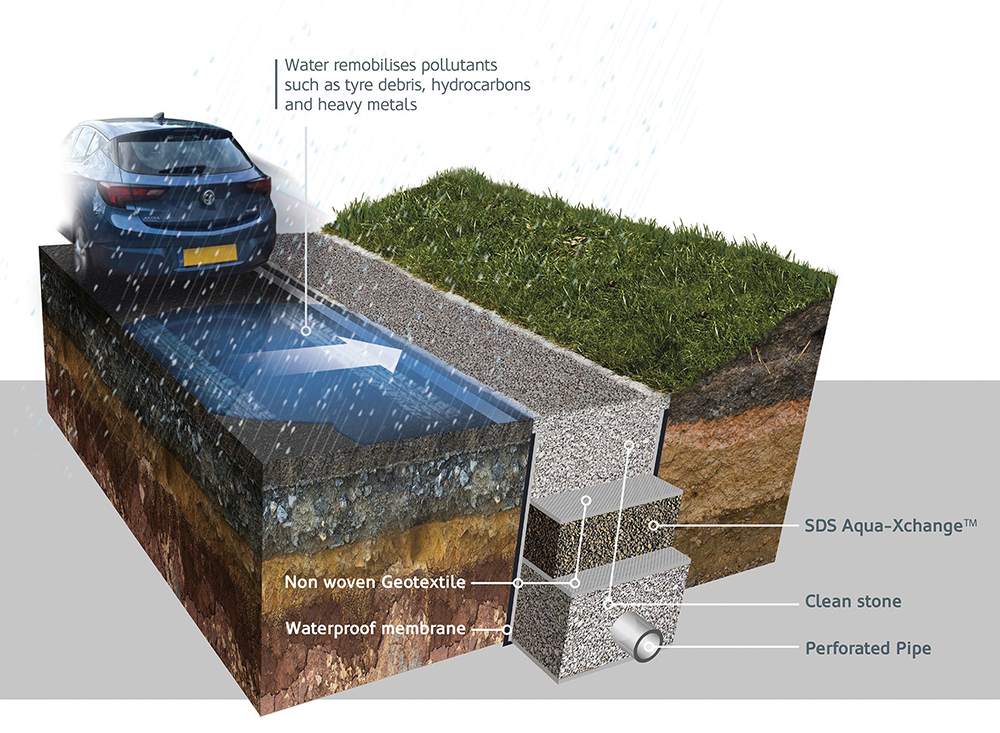A groundbreaking new sustainable drainage material is offering a simple and versatile solution to removing toxic heavy metals pollution from highways.
Developed by the leading water infrastructure systems provider SDS Limited, SDS Aqua-XchangeTM is a flexible and highly-efficient granular material that captures copper and zinc in surface water runoff from motorways, trunk roads and other high-traffic areas.
SDS Aqua-XchangeTM is an engineered treatment media that can be used in regulatory-compliant Sustainable Drainage Systems (SuDS). It has been proven in independent testing to achieve 99% removal of dissolved copper and zinc, toxic metals identified by Highways England as ‘priority pollutants’ and subject to strict regulatory controls.
Delivered to site in lightweight, one cubic metre bags, SDS Aqua-XchangeTM is now available for consulting engineers and infrastructure contractors to deploy as stormwater treatment in highways drainage, as well as on other higher risk locations such as retail car parks, freight and logistics hubs.
SDS worked with scientists at the University of Chester to perfect SDS Aqua-XchangeTM. A unique combination of naturally-occurring materials, it uses the processes of adsorption and ionic exchange to form unbreakable bonds with the heavy metals, including copper and zinc, capturing and retaining them even in heavy storms.
“We are excited to have created an affordable and truly versatile new SuDS material that can be used in both existing and new drainage schemes and requires minimal maintenance,” said SDS Market Development Manager Jo Bradley, who led the development project.
“When a risk assessment, conducted according to Highways England’s Design Manual for Roads & Bridges, identifies unacceptably high levels of soluble copper and zinc, then action must be taken to treat the pollution. In a situation like this, SDS Aqua-XchangeTM comes into its own, because it gives designers unprecedented flexibility to add the material to a range of SuDS components and boost their treatment performance.
“Because of its granular composition, SDS Aqua-XchangeTM has a large active surface area, enabling high-performance pollutant removal in a small space. As a result, it can be used to deliver pre-treatment as part of a vegetative SuDS scheme, enabling smaller SuDS ponds or wetlands to be designed where otherwise there would have been no room for them.”
In a typical application, a layer of SDS Aqua-XchangeTM can be added as an additional component to a linear filter drain. Installed at a shallow depth, contractors avoid costly excavation or use of heavy cranes.
SDS Aqua-XchangeTM can also be combined effectively with other proprietary SuDS devices. As it can filter out finer silts and sediments, it can be deployed downstream of a hydrodynamic vortex separator such as SDS Aqua-SwirlTM that targets larger particles. It can also be combined with geocellular storage, such as SDS GEOlight®, when additional attenuation is needed as part of the roadside treatment system.
Compliant with guidelines in CIRIA C753 The SuDS Manual, SDS Aqua-XchangeTM can be included as a component in vegetative SuDS devices such as dry swales, raingardens or bio-remediation zones, so that robust retention of copper and zinc is completely assured while plants can continue to thrive as part of the landscaped design.
Jo Bradley continues: “Toxic metals carried in surface water runoff from roads and other heavy-traffic locations threaten the health of our rivers and streams through persistent and bio-accumulative pollution. Incapable of being broken down biologically, they become attached to silts and sediments and dissolve in the runoff washed off hard surfaces during heavy rain.
“This pollution is the result of tyre erosion, dust from brake and clutch pads, fuel and lubricants from engine wear and exhaust emissions. The pollutants attach to silts and sediments in surface water when it rains, and some are dissolved in the water. As a result, persistent, toxic and bio-accumulative pollutants are carried into rivers, streams and groundwater. Copper and zinc are directly toxic, so can affect aquatic species as soon as they enter the watercourse.
“Not only has SDS Aqua-XchangeTM been proven to remove and capture 99% of the copper and zinc, but also to retain these metals even when applications of road salt were simulated.
Aqua-XchangeTM was tested to reflect a range of rainfall conditions under the observation of an independent representative from a UKAS-accredited laboratory in accordance with the British Water protocol.
For more information about SDS Aqua-XchangeTM contact Joanna.Bradley@sdslimited.com or visit www.sdslimited.com.




